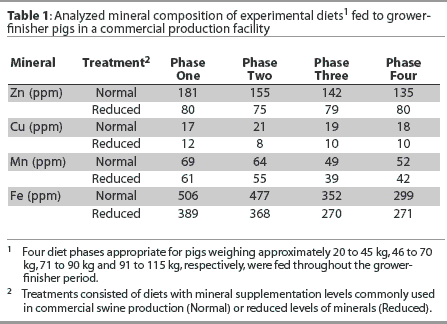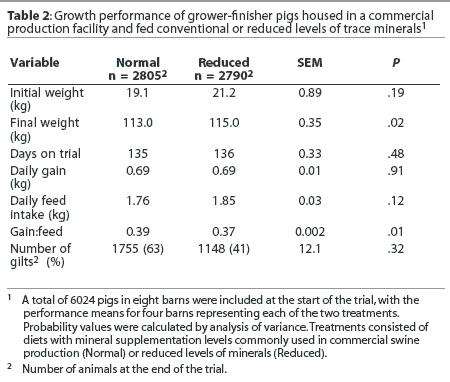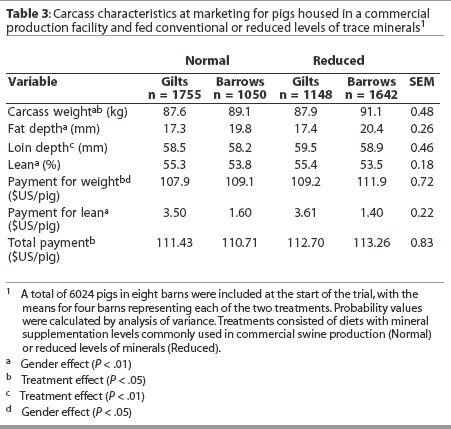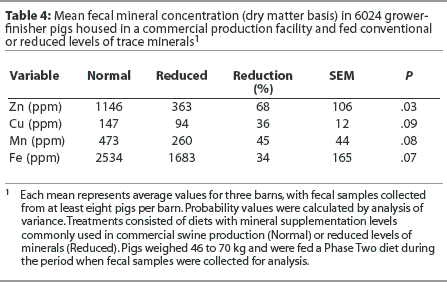Original research |
Peer reviewed |
Growth performance, carcass characteristics, plasma minerals, and fecal mineral excretion in grower-finisher swine fed diets with levels of trace minerals lower than common industry levels
Eric van Heugten, MS, PhD; Patrick R. O'Quinn, MS, PhD; David W. Funderburke, MS, PhD; William L. Flowers, MS, PhD; Jerry W. Spears, MS, PhD
EVH, WLF, JWS: Department of Animal Science, North Carolina State University, Raleigh, North Carolina. PRO, DWF: Cape Fear Consulting, LLC, Warsaw, North Carolina. Corresponding author: Dr Eric van Heugten, PO Box 7621, Department of Animal Science, North Carolina State University, Raleigh, NC 27695-7621; Tel: 919-513-1116; Fax: 919-515-6316; E-mail: Eric_vanHeugten@ncsu.edu
Cite as: van Heugten E, O'Quinn PR, Funderburke DW, et al. Growth performance, carcass characteristics, plasma minerals, and fecal mineral excretion in grower-finisher swine fed diets with levels of trace minerals lower than common industry levels. J Swine Health Prod. 2004;12(5):237-241.
Also available as a PDF.
Summary
Objectives: To determine the impact of lowering levels of supplemental trace minerals (TM) below those commonly fed to grower-finisher swine on fecal mineral excretion, growth performance, carcass characteristics, and economic return.
Methods: Pigs (n = 6024) were randomly distributed into four blocks of two barns per block and allotted within block to diets with either Normal (industry levels) or Reduced TM supplementation. Growth performance was measured for each barn, and individual carcass characteristics were recorded at a commercial packing plant. Fecal samples randomly obtained from at least eight pigs per barn were analyzed for zinc, copper, iron, and manganese. Plasma samples from six pigs per barn were analyzed for zinc, copper, and iron.
Results: In pigs fed Reduced TM diets, fecal levels were lower for zinc (P < .05), and tended to be lower for copper, iron, and manganese (P < .10), than in pigs fed Normal TM diets. Carcass weight, carcass weight payment, and total payment were greater for pigs fed Reduced TM diets (P < .05), which may have been partly due to greater weight at placement and uneven gender distribution. Backfat thickness, loin depth, percent lean, and lean premium payment did not differ between treatments (P > .05).
Implications: Fecal excretion of zinc was significantly lower, and excretion of copper, iron, and manganese tended to be lower, in grower-finisher pigs fed diets containing trace mineral levels lower than common industry standards. Carcass characteristics were not negatively affected.
Keywords: swine, trace
minerals, growth, carcass characteristics, nutrient excretion
Search the AASV web site
for pages with similar keywords.
Received: November
9, 2003
Accepted: December
20, 2003
Piglets for grower-finisher pigs in commercial production are commonly supplemented with zinc and copper at levels greater than those suggested by the National Research Council (NRC).1 Analysis of 17 finishing feeds submitted to the North Carolina Feed Testing Laboratory by swine producers in North Carolina indicated that dietary zinc concentration ranged from 103 to 205 ppm and dietary copper concentration ranged from 9 to 281 ppm.2 In comparison to the NRC1 requirements for grower-finisher pigs, the analyzed concentrations of zinc and copper in practical diets averaged 3.0 and 6.7 times greater, respectively. These differences may be due to high mineral concentrations in certain feed ingredients, but they are most likely the result of individual preferences of nutritionists to ensure that the requirements of pigs are met under different production and management environments and different health conditions. High doses of copper and zinc are often added for growth promotion, primarily in diets for nursery pigs. Accumulation of zinc and copper in soils may be of concern in areas where manure from swine facilities is applied extensively.3-5 Thus, reducing supplemental levels of these trace elements may be of benefit for sustainable swine production.
Creech et al6 evaluated the effects of lowering trace mineral supplementation from levels commonly used in the industry to levels suggested by the NRC.1 In that study, supplemental levels of zinc and copper in grower-finisher pig diets were reduced from 100 to 25 ppm and 15 to 5 ppm, respectively. In addition, the levels of iron and manganese were reduced from 100 to 25 ppm and 40 to 10 ppm, respectively, to minimize antagonistic effects of these minerals on absorption of zinc and copper. Results demonstrated that reducing trace mineral levels reduced zinc and copper excretion in feces of gilts by at least 40% without affecting growth performance under university herd conditions.6
Because of a more challenging production environment, lower feed consumption, and potential health problems, it may be necessary, under commercial conditions, to increase the dietary levels of supplemental minerals above NRC recommendations.1 Klasing7 suggested that trace mineral requirements to optimize immune function and health may be greater than requirements for growth performance. Thus, the objectives of the present study were to evaluate the effects on pig performance and carcass characteristics under commercial conditions when trace minerals were supplemented at levels lower than those commonly used in the swine industry, and to determine the effect of lowering dietary trace minerals on mineral excretion in swine feces.
Materials and methods
Experimental design
A total of 6024 pigs (Dekalb genetic background) were randomly allotted to four blocks, with two barns per block. All barns were of the same dimensions, and barns were curtain-sided and tunnel-ventilated, with completely slatted floors. Each block of barns was filled at the same time with pigs from the same nursery, without sorting for gender. Barns were then assigned, within block, to either a diet with levels of supplemental trace minerals commonly used in the swine industry (Normal) or a diet with lower levels of copper, zinc, and iron (Reduced). Four diet phases appropriate for pigs weighing approximately 20 to 45 kg, 46 to 70 kg, 71 to 90 kg, and 91 to 115 kg, respectively, were fed, with 135 ppm, 125 ppm, 105 ppm, and 85 ppm added zinc; 13.5 ppm, 12.5 ppm, 10.5 ppm, and 8.5 ppm added copper; and 113 ppm, 104 ppm, 87.5 ppm, and 70 ppm added iron, respectively, for the Normal trace mineral diets; and 30 ppm added zinc, 6 ppm added copper, and 30 ppm added iron for all Reduced trace mineral diets. Levels of supplemental manganese did not differ between dietary treatments. Levels of manganese in the Normal trace mineral diets were 27 ppm, 25 ppm, 21 ppm, and 17 ppm for diet Phases One to Four, respectively, due to a decreasing rate of mineral premix inclusion, and were kept at a constant level of 25 ppm for the Reduced trace mineral diets.
Diets were composed primarily of corn and soybean meal with high levels of added fat, vitamins, and synthetic amino acids to mimic commercial formulations. Diet Phases One to Four were formulated to contain 1.14%, 0.99%, 0.83%, and 0.75% total lysine, 0.72%, 0.64%, 0.57%, and 0.51% calcium, and 0.66%, 0.59%, 0.53%, and 0.47% phosphorus, respectively. Feed samples, collected from at least four randomly selected feeders within each barn every time a new batch of feed was mixed, were analyzed for zinc, copper, iron, and manganese. The analyzed mineral composition of each of the diets (Table 1) exceeded NRC1 recommendations.

Performance and carcass measurements
Pigs were placed in the grower-finisher barns on the basis of nursery of origin, such that each block of barns received pigs from the same nurseries in May and June. Pigs were not sorted by gender in the nursery. They were shipped to the finishing site by truck, and were then placed in the finisher barns in a random manner. Initial weights for each barn were recorded. At the time of first marketing, pigs were sorted by weight, and those that met the weight criteria were shipped to a commercial packing plant. These marketing shipments were conducted for each block of barns at the same time to avoid confounding of treatments with time of marketing. Weights of pigs in each marketing group were recorded for each barn. A total of four shipments were made, and all pigs had been shipped by October and November.
Total number of days on trial was calculated from the starting and ending dates for each marketing group of pigs and the number of pigs in each group. Average daily gain was calculated from the total weight at placement, total weight at marketing, and the total number of days to marketing. Feed disappearance was calculated from the total feed delivered to each barn, corrected for feed remaining at the end of the trial, the number of pigs in each barn, and the total number of days on trial.
Carcass measurements of each individual pig in each marketing group were collected at a commercial packing plant. Information collected at the packing plant included gender, hot carcass weight, back fat and loin depth (using an optical probe), percent lean, payment for the carcass (based on weight only), payment premium for leanness (for the carcass), and total payment (for the entire carcass including payment for lean).
Sampling and analyses
Fresh fecal samples were obtained randomly upon defecation from at least eight pigs in each barn during the time when pigs were consuming Phase Two diets. Samples were combined within a barn, dried in an oven at 60°C, and then ground through a 1-mm screen prior to mineral analysis. At the time when fecal samples were collected, blood samples were also collected from six randomly selected pigs in each barn using heparinized tubes appropriate for trace mineral analysis (Vacutainer; Becton Dickinson, Rutherford, New Jersey).
Feed and fecal samples were digested by wet ashing with nitric acid and hydrogen peroxide using a microwave digestion system8 (Model MDS-81D; CEM Corp, Matthews, North Carolina). Ashed samples were subsequently analyzed for zinc, copper, iron, and manganese using an atomic absorption spectrophotometer (model AA-6701F; Shimadzu, Kyoto, Japan). Plasma samples were diluted in nitric acid, then analyzed by atomic absorption spectrophotometer.8
Statistical analyses
Data were analyzed by analysis of variance as a randomized complete block design using the General Linear Models procedure of SAS (SAS Institute Inc, Cary, North Carolina). The model for growth performance, mineral excretion data, and plasma mineral concentrations included block (barns) and trace mineral inclusion level (Normal and Reduced), using barn as the experimental unit. The model for carcass data included block, trace mineral supplementation level, gender, the interaction of trace mineral supplementation and gender, and the interaction of block and trace mineral supplementation level. The latter was used as an error term to test the effect of trace mineral supplementation on carcass characteristics. The experimental unit for this analysis was the individual pig. In addition, carcass data were analyzed using carcass weight as a covariate to evaluate carcass characteristics at a common carcass weight.
Results
Growth and carcass characteristics
Pigs fed diets containing the Reduced levels of trace minerals were heavier at the time of marketing (P < .05) and were less efficient than pigs fed the Normal levels of minerals (Table 2). However, although pigs were randomly assigned within each block of barns, it was noted at the packing plant that in the group receiving the Reduced mineral supplementation, 1148 of 2790 pigs (41%) were gilts, while in the group fed the Normal mineral supplementation, 1755 of 2805 pigs (63%) were gilts. This difference in gender distribution between treatments was not statistically significant (P > .05). In addition, the difference in final weight between treatment groups was 2.0 kg, which was similar to the difference of 2.1 kg in initial weight, resulting in no effect of treatment on daily weight gain.

Carcass weight and back fat depth were greater, and percent lean and payment for lean were lower, for barrows than gilts (Table 3). Carcass weight, loin depth, payment for weight, and total payment were greater for pigs fed diets with Reduced levels of minerals (Table 3). Additional analysis of the data, using carcass weight as a covariate (data not shown), indicated that final payment for the carcass was greater (P < .01) in pigs fed the Reduced mineral diets, but no other differences between treatments were evident (P = .13).

Fecal mineral excretion
Feces of pigs fed diets with Reduced levels of trace minerals contained significantly less zinc, and tended to contain less copper, iron, and manganese, compared to pigs fed industry levels of trace minerals (Table 4). These data are based on observations of three barns per treatment. For the fourth set of barns, not used in the statistical analysis of excretion data, diets were deposited in the wrong feed bins, as verified by mineral analysis of the feed for that period. Diets were erroneously switched approximately 1 week before fecal samples were obtained, and the wrong diets were still being fed at the time fecal samples were obtained. The error in feed delivery was confined to this instance, as verified by mineral analysis of feed samples obtained for each batch and each barn. When results from the two barns for which diets had been erroneously switched were evaluated separately, mineral excretion levels were 1154 ppm for zinc, 217 ppm for copper, 2718 ppm for iron, and 453 ppm for manganese in pigs that were actually consuming the Normal mineral diets. Mineral excretion was much lower in pigs actually consuming the Reduced mineral diets: 463 ppm for zinc, 97 ppm for copper, 2230 ppm for iron, and 270 ppm for manganese.

Plasma mineral concentrations
Plasma mineral concentrations were not affected by dietary treatment. Mean plasma mineral concentrations were 0.70 mg per L zinc, 2.17 mg per L copper, and 1.32 mg per L iron for pigs fed the Reduced mineral diet, and 0.67 mg per L zinc, 2.08 mg per L copper, and 1.34 mg per L iron for pigs fed the Normal mineral diet. These results are based on three observations per treatment. In pigs from the two barns for which diets had been erroneously switched, plasma concentrations were 0.64 mg per L zinc, 2.41 mg per L copper, and 1.34 mg per L iron for pigs consuming the Reduced mineral diet, and 0.54 mg per L zinc, 2.24 mg per L copper, and 1.07 mg per L iron for pigs consuming the Normal mineral diet.
Discussion
In spite of the fact that pigs were randomly distributed in barns with regard to gender and body weight, there were numerically fewer gilts in the treatment group receiving the Reduced mineral diet than in the treatment group receiving the Normal mineral diet. Although the difference in gender distribution between treatments was not statistically significant, it may have confounded the results. Slower growth rates and superior feed efficiency of gilts compared to barrows have been clearly demonstrated in several genetic lines of swine.9 Therefore, the differences in growth performance between treatments observed in the present study may have been due, in part, to differences in gender distribution.
We observed more desirable carcass characteristics in gilts compared to barrows, which is in agreement with the reported literature. Goodwin and Burroughs9 evaluated carcass characteristics of six terminal lines and reported higher back fat thickness and lower loin eye area and percent fat-free lean in barrows than in gilts.
Consistent with the present study, Creech et al6 reported that in gilts fed diets with levels of trace minerals equivalent to NRC1 recommendations, growth performance and feed efficiency during the nursery and grower-finisher phases were similar to those of gilts fed levels of trace minerals often used in the industry. However, carcass characteristics were not evaluated in that study. Paboeuf et al10 reported no differences in growth performance and carcass characteristics for barrows and gilts fed diets with reduced levels of copper, zinc, or both in either the finisher period or the entire grower-finisher period. The greater carcass weight for pigs fed diets with Reduced mineral supplementation in the present study is consistent with the higher final live weight reported in Table 2 and may have been largely due to the greater weight at placement. Thus, the greater loin depth, payment for weight, and total payment for pigs fed reduced trace mineral levels appeared to be a result of heavier carcass weights. Results of the current study and those reported by others6,10 suggest that levels of trace minerals fed under commercial conditions may be reduced to levels closer to those recommended by the NRC1 without a negative impact on pig performance, carcass characteristics, or economic value of the carcass.
Copper is excreted via the bile in the feces, with only minute amounts being excreted in the urine.11 Similarly, the main excretory route of zinc is through the feces.12 Absorption and excretion of copper and zinc are strictly regulated through homeostatic control mechanisms, and when these minerals are consumed in quantities exceeding the requirement, the excess will be excreted.13 Therefore, analysis of fecal samples in the present experiment provides an accurate estimate of the potential reduction in mineral excretion that can be obtained by reducing dietary concentration of trace minerals.
In agreement with these results, Creech et al,6 in a similar study, suggested that zinc and copper excretion could be reduced by at least 40% by reducing trace mineral supplementation to levels recommended by NRC.1 Paboeuf et al10 reported that excretion of copper was lowered by 76%, and that of zinc by 14%, when pigs were fed diets containing reduced levels of copper and zinc. In that study, total concentration of copper in the feed for control pigs was 92 ppm, and this was reduced to 15 to 18 ppm in the reduced mineral diet. Because of the much higher concentration of copper in the positive control diet used in the experiment reported by Paboeuf et al,10 it would be expected that the relative excretion of copper would be much greater in that trial than in our experiment. On the other hand, zinc was reduced from approximately 125 ppm to 90 ppm total zinc in that study,10 while total zinc was reduced from an average of 153 to 79 ppm in the current experiment, which would be likely to result in a greater reduction in zinc excretion in our experiment. Although dietary manganese was similar between treatments in the current study, there was a tendency for fecal manganese to be reduced. The reduction in dietary levels of zinc, copper, and iron might have increased the availability of manganese, resulting in reduced excretion.
Considering that performance and feed intake of pigs did not appear to be affected by lower levels of trace minerals in the diets, mineral excretion could be substantially reduced during the entire grower-finisher phase by reducing trace mineral concentration in the diet. Jongbloed and Lenis4 calculated that the total excretion of copper could be reduced from 14.4 g to 4.6 g per pig in pigs weighing 25 to 106 kg by eliminating growth-promoting levels of copper in the starter phase and reducing dietary copper from 35 ppm to 20 ppm in the grower-finisher phase. Total excretion of zinc could be reduced from 21.6 g to 10.9 g per pig when dietary zinc was reduced by approximately 50%. Copper and zinc may accumulate in soil and cause leaching and runoff when excessive amounts of swine waste or lagoon effluent are applied.3-5 As demonstrated in the current study and results reported by others,6,10 a significant reduction in excretion of these trace minerals is possible through nutritional manipulation, thereby minimizing the potential impact on the environment.
Creech et al6 reported that plasma zinc was significantly lower in gilts fed diets with reduced levels of trace minerals during the nursery and grower phase, but was affected only during the finisher phase in one of the three trials conducted. Plasma copper levels were not affected by trace mineral supplementation level in that study.6 Puls14 reported that serum concentrations of 0.70 mg per L to 1.50 mg per L zinc, 1.30 mg per L to 3.00 mg per L copper, and 1.00 mg per L to 1.50 mg per L iron were within normal physiological levels. Plasma concentrations of these minerals were within these ranges in the present experiment, although plasma zinc concentration may have been marginally low. However, we did not observe differences in plasma mineral levels between treatments, suggesting that mineral status was not compromised due to feeding reduced levels of trace minerals.
Implications
- Fecal mineral excretion of zinc was lower and excretion of copper, iron, and manganese tended to be lower in grower-finisher pigs fed diets containing reduced levels of trace minerals compared to levels commonly used in the swine industry.
- Grower-finisher pig performance, carcass characteristics, and carcass value were not negatively affected by levels of trace minerals lower than those commonly used in the swine industry.
- Feeding reduced levels of trace minerals may have a positive impact on the environment.
References
1. National Research Council. Nutrient Requirements of Swine. 10th ed. Washington, DC: National Academic Press; 1998.
2. Spears JW. Optimizing mineral levels and sources for farm animals. In: Kornegay ET, ed. Nutrient Management of Food Animals to Enhance and Protect the Environment. Boca Raton, Florida: Lewis Publishers; 1996:259-275.
3. Burns JC, Westerman PW, King LD, Overcash MR, Cummings GA. Swine manure and lagoon effluent applied to a temperate forage mixture: I. Persistence, yield, quality, and elemental removal. J Environ Qual. 1987;16:99-105.
4. Jongbloed AW, Lenis NP. Excretion of nitrogen and some minerals by livestock. In: Verstegen MWA, den Hartog LA, van Kempen GJM, Metz JHM, eds. Nitrogen Flow in Pig Production and Environmental Consequences. Wageningen, The Netherlands: Pudoc Scientific; 1993:22-36.
*5. Tucker MR. Experiences with metal toxicities in North Carolina. Proc Soil Sci Soc N C. 1997;40:97-103.
6. Creech BL, Spears JW, Flowers WL, Hill GM, Lloyd KE, Armstrong TA, Engle TE. Effect of dietary trace mineral concentration and source (inorganic vs. chelated) on performance, mineral status, and fecal mineral excretion in pigs from weaning through finishing. J Anim Sci. 2004;82:2140-2147.
7. Klasing KC. Protecting animal health and well-being: nutrition and immune function. In: National Research Council, ed. Scientific Advances in Animal Nutrition: Promise for the New Century. Washington, DC: National Academy Press; 2001:13-20.
8. Gengelbach GP, Ward JD, Spears JW. Effect of dietary copper, iron, and molybdenum on growth and copper status of beef cows and calves. J Anim Sci. 1994;72:2722-2727.
*9. Goodwin R, Burroughs S. Genetic Evaluation Terminal Line Program Results. Des Moines, Iowa: National Pork Producers Council; 1995.
10. Paboeuf F, Nys Y, Corlouër A. Réduction des rejets en cuivre et en zinc chez le porc charcutier par le diminutation de la supplémentation minérale. [A study of the effects of a reduction in copper and zinc supplementation in growing/finishing pig diets on performance and excretion.] Journées de la Recherche Porcine en France. 2000;32:59-66.
11. Mahoney JP, Bush JA, Gubler CJ, Moretz WH, Cartwright GE, Wintrobe MM. Studies on copper metabolism. 15. Excretion of copper by animals. J Lab Clin Med. 1955;46:702-708.
12. Weigand E, Kirchgessner M. Total true efficiency of zinc utilization: Determination and homeostatic dependence upon the zinc supply status in young rats. J Nutr. 1980;110:469-480.
13. Underwood EJ. Trace Elements in Human and Animal Nutrition. New York: Academic Press; 1977.
14. Puls R. Mineral Levels in Animal Health. 2nd ed. Clearbrook, British Columbia, Canada: Sherpa International; 1994.
* Non-refereed references
